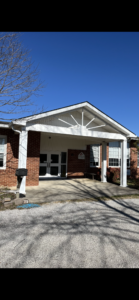 The only constant in life is change. Take Dry Valley School, for instance.
The only constant in life is change. Take Dry Valley School, for instance.
Though I haven’t voted there for several years (I’m a poll worker elsewhere and must cast my ballot early), I can’t help but grieve the recent closing of my dear little precinct. I understand why the election commission decided to send its voters elsewhere. Dry Valley is small. It’s remote. Turnout there on Election Day has been consistently low for a number of years. It didn’t make sense to keep it open.
Because it’s close to where I live, I stopped by last week in hopes of taking a nostalgic walk through the building. The red brick schoolhouse is nestled in a quiet spot at the base of Phifer Mountain. Daffodils bloom in great waves in the field across the road this time of year. Below the parking lot, big rocks spell out the words DRY VALLEY SCHOOL. The front porch is deep and welcoming.
Folks who now use Dry Valley as a satellite office for Putnam County Schools were kind enough to show me around. The dining room where we voted has been partitioned into cubicles. Otherwise, the building is as I remembered. A deep mop sink in the kitchen. Wide halls. Sunlight streaming in through the wall of windows in every room.
I began to wonder about the history of the school. When was it built? What grades did it serve? When did it become the county’s alternative school? What year did it become offices? Those who work there and at the “big” central office were happy to share with me what they knew, but answers were hard to come by.
And then I remembered that my friend Randy Mansell, who teaches at Cookeville High School and lives at the tip-top of Phifer Mountain Road, once mentioned that he went to school at Dry Valley. So I called him.
Lucky for me, Randy’s memory is sharp. Not only did he attend school at Dry Valley, but his dad–Taylor Mansell–did, too, and also remembers a lot. The original school building burned in the early 1950s but was rebuilt on the same spot. In 1955, the seventh and eighth grade boys’ basketball team, of which Taylor was a member, won the junior high state championship. And they did it without a gym to practice in! Basketball was played then (and always) on the asphalt pad behind the schoolhouse. That court, complete with worse-for-wear-but-still-standing goals at either end, is still there.
Randy was a student at Dry Valley from 1968 through spring of 1971, when he finished third grade. “We had first through eighth graders all in one room, taught by one teacher,” he told me. “The Superintendent of Schools had promised that Dry Valley could stay open as long as at least 45 students were enrolled. When our numbers dropped below that, we were shut down and bused to Capshaw. It was a real sad time.” The worst part, he says, was giving up the wonderful school lunches at Dry Valley. “Mrs. Hill cooked for us,” he said. “And when our teacher had to be absent, she served as the substitute, too. The amazing thing is that Mrs. Hill also cooked and taught when my dad was in school. We loved her and we loved her ole-timey country cooking. Not one of us Dry Valley kids ever got over the awful food kids in city schools had to eat.”
After its students were sent away, Dry Valley sat empty for a while before re-opening as the county’s alternative school. In 2010, the school was converted to offices.
Knowing that my neighbors were gathering and voting in that building has always been one of my favorite things about Election Day. And though I understand that the only constant in life is change, the closing of my dear little precinct has left a great big hole in my sentimental heart.
(March 2, 2024)